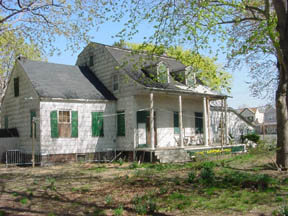Jamaica Bay and the Rockaways
The Daily Plant : Thursday, May 2, 2002
HISTORIC HOUSE TRUST RECEIVES $500,000 GRANT

On Saturday, April 20, 2002, Governor George Pataki announced that the Historic House Trust of New York City has been awarded a grant of $500,000 for exterior restoration of the Hendrick I. Lott House in Marine Park, Brooklyn.
The grant is an award from the New York State Office of Parks, Recreation and Historic Preservation through the Clean Water / Clean Air Bond Act of 1996. These funds will allow the Trust to perform a thorough exterior restoration and mechanical systems upgrade on this 18th century building so that it can be used as a museum. The Trust, Parks’ private partner for the preservation and interpretation of historic house sites in parks, will work with Parks’ Capital Division on the project. The design process will begin this summer.
One of the finest of the 20 Dutch farmhouses remaining in New York City, the Lott House is a remarkable witness to almost 300 years of Brooklyn history. Today, in order to prevent the house from being lost to development, the Lott House and the 0.75 acre surrounding it are in the process of being acquired by Parks and mapped as parkland.
The Lott House’s history mirrors major developments in American history in the 18th and 19th centuries. Members of the family served in New York’s colonial assembly during the early 18th century and on the Continental Army during the Revolutionary War. Throughout the 18th century, the Lotts worked their land using slave labor. Archaeologists from Brooklyn College recently uncovered evidence of slave life – including a cosmogram, West African religious symbol, fashioned out of corncobs and shells – in an attic crawl space in the 1720 section of the house, the first such evidence to be found in any house in New York City. The Lotts freed their slaves by 1810, well before slavery was abolished in New York State in 1827. A tiny room behind a hidden door in an upstairs closet, papered over with local broadsheets dated 1852, shows that the family went on to express their abolitionist views by participating in the Underground Railroad.
After the Civil War, Hendrick Lott’s descendants sold off land to developers. The farm was gradually reduced from over 200 acres in the mid-19th century to 25 acres in 1920 and 0.75 acre today. The last Lott descendant to occupy the house, Ella Lott Suydam, died there in 1989.
Because the Lott House was solidly framed when it was built in the 1700s, damage to the building as a result of age and neglect is limited to deterioration. These effects can be reversed. However, if the house was to continue to suffer from exposure to the elements without extensive repair, it would inevitably collapse. This $500,000 award from the State will allow the Trust and Parks not only to save the house, but also to turn it into a museum that tells the story of the Lott family’s three centuries in Brooklyn.
By Sarah Landreth
THIRTEEN YEARS AGO IN THE PLANT
(Wednesday, May 9, 1989)
BRONX SHORELINE GETS SPRUCE-UP
A group of community volunteer workers, armed with rakes, shovels and garbage bags, joined forces with Parks employees last Thursday to launch a massive one-day spruce-up on the shoreline of Van Cortlandt Lake in the Bronx.
The labors began when Van Cortlandt and Pelham Bay Parks Administrator Paul Berizzi received a telephone call from Ray Ramirez, a concerned Inwood resident inquiring about a volunteer clean-up of the Van Cortlandt lake shoreline. Berizzi, who coordinated the clean-up, suggested a cooperative effort with Parks, in which the joint group would clean debris from the water and shoreline.
QUOTATION FOR THE DAY
"The child supplies the power but the parents have to do the steering."
Dr. Benjamin Spock
(May 2, 1903- 1998)




